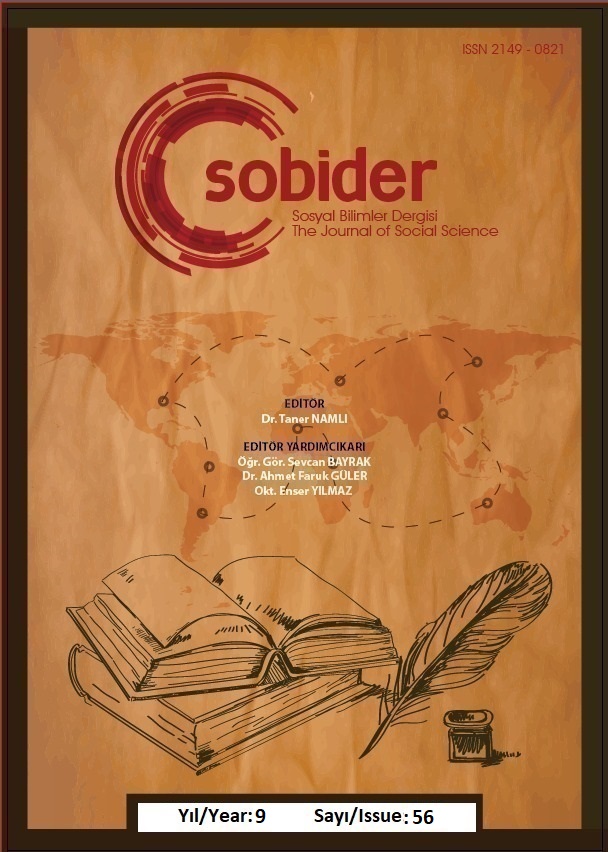Author :
Abstract
Toplumsal yaşam içerisinde insanoğlunun dil yoluyla iletişime geçerken söylediği her sözce, söylenme sebebine, söylendiği yere, zamana ve ortam koşullarına göre bir anlam ifade etmektedir. Dilbilim çalışmaları içerisinde kiplik kavramı da ifade edilen düşüncelerin, tavırların, görüşlerin, konuşma şeklinin öznellik, gerçek dışılık, iddiasızlık, olasılık ve zorunluluk gibi tümce anlamını etkileyen unsurlarını ele almaktadır. Tümce anlamını etkiyen bu kiplik işaretleyiciler, sözceler içerisinde tek başına, söz dizimsel ve dil bilgisel ögeler olarak ifade edilmektedir. Önerme (bilgi) kipliklerinin bir alt kategorisi olan olasılık kiplikleri de tahmin, çıkarım, izin, yeterlilik, şüphe, uyarı gibi pek çok ifade alanıyla tümce anlamını etkileyen kiplik türü olarak biçimbirimlerde, çoklu yapılarda ve sözcüklerde karşımıza çıkmaktadır. 15. yüzyılın sonu ile 16.yüzyılın başlarında yazılan Süleymannâme-i Kebir adlı eser eğitici, öğretici ve kıssadan hisse almaya yönelik tarzda yazılmış 81 ciltlik bir eserdir. Anlatılan hikâyelerde yazar, hikâyenin gerçekte neyi temsil ettiğini okuyucuya konuşma üslubu içerisinde aktarmaya çalışmıştır. Kahramanların gerçekleştirdiği diyaloglar anlatıma canlılık katmış ve metni akıcı hale getirmiştir. Hikâyenin akışı içinde kiplik işaretleyicileri kullanarak kahramanların tavır, görüş ve düşüncelerini ifade etmiştir. Diyaloglarda olasılık, tahmin, varsayım gibi duygu ve düşünceler ifade edilirken ek, çoklu yapılar ve sözler gibi kiplik işaretleyicilere yer verilmiştir. Metnin bağlamı içerisinde bu işaretleyiciler aslî görevlerinin yanında tümceye olasılık anlamını veren işaretleyiciler olarak kullanılmıştır. Bu çalışmada Süleymannâme-i Kebir’de olasılık kiplik işaretleyicisi olarak kullanılan biçimbirimler, çoklu yapılar ve sözcükler tespit edilerek Süleymannâme’nin 40. cildinden alınan örneklerle tanıklanmıştır.
Keywords
Abstract
Every utterance that human beings say while communicating through language in social life has a meaning according to the reason it was said, the place where it was said, the time and the environmental conditions. In linguistic studies, the concept of modality also deals with the elements of the expressed thoughts, attitudes, opinions, and the way of speaking that affect the meaning of the sentence such as subjectivity, unreality, unpretentiousness, possibility and necessity. These modal markers, which affect sentence meaning, are expressed as syntactic and grammatical elements alone in utterances. Probabilistic modalities, which are a subcategory of propositional (knowledge) modalities, appear in morphemes, multiple structures and words as a type of modality that affects the meaning of sentences with many expression fields such as prediction, inference, permission, adequacy, doubt, warning. The work called Süleymannâme-i Kebir, which was written at the end of the 15th century and the beginning of the 16th century, is an 81-volume work written in a way that is educational, instructive and points a moral. In the stories told, the author tried to convey to the reader what the story actually represents, in a speaking style. The dialogues performed by the heroes added vitality to the narrative and made the text fluent. The author expressed the attitudes, views and thoughts of the heroes by using modality markers in the flow of the story. While expressing feelings and thoughts such as probability, estimation and assumption in the dialogues, modality markers such as suffixes, multiple structures and words are included. In the context of the text, these markers are used as markers that give the meaning of probability to the sentence, besides their main function. In this study, morphemes, multiple structures and words used as probabilistic modality markers in Süleymannâme-i Kebir were identified and witnessed with examples taken from the 40th volume of Süleymannâme.
Keywords
- Aksan, Doğan (1983). Sözcük Türleri. Ankara: TDK Yayınları.
- Aksan, Doğan (2016). Anlambilim Konuları ve Türkçenin Anlambilimi. İstanbul: Bilgi Yayınları.
- Boz, E. (2012). Türkiye Türkçesi biçimsel ve anlamsal işlevli biçimbilgisi (tasnif denemesi). Ankara: Gazi Kitabevi.
- Bulak, Şahap (2017).Türkçede Gereklilik İfadesinin Kip Hüviyeti Kazanmadan Önceki Gelişim Süreci. ekev Akademi Dergisi.
- Canım, R.(2000). Tezkiretü’ş-Şuarâ ve Tabsıratü’n-Nuzamâ. Ankara: Atatürk Kültür Merkezi Başkanlığı.
- Çekin, Abdulkadir, Mustafa, Gören (2013). Dil Bilimi ve Kelime Semantiğinde Bazı Türkçe Kelimelerin Çeşitli Anlam Değişmeleri. 21. Yüzyılda Eğitim ve Toplum Cilt 2 Sayı 4.
- Demir Aslan, Sema (2008). Türkçede İsteme Kipliği: Semantik-Pragmatik Bir İnceleme. Ankara: Grafiker Yayınları.
- Ergin, Muharrem (1993). Türk Dil Bilgisi. İstanbul: Bayrak Basım Yayım Tanıtım.
- Erguvanlı Taylan, E. (2018). Türkçede dilbilgisel kiplikte olasılık ve gereklilik. Mersin Üniversitesi Dil ve Edebiyat Dergisi, s. 1-22.
- Göksel, Aslı, Kerslake, Celia (2005). Turkish: A Comprehensive Grammar, London and Newyork.
- Gülsevin, Gürer; Boz, Erdoğan (2004). Eski Anadolu Türkçesi. Ankara: Gazi Kitabevi.
- Hirik, Seçil (2010). Eski Uygur Türkçesinde Kiplik. Gazi Üniversitesi Sosyal Bilimler Enstitüsü. (Yayımlanmamış Yüksek Lisans Tezi). Ankara.
- Kılıç, Filiz (2004). Kırgız Türkçesinde Bilgi Kipliği: Delile Dayananların Diğer Bilgi Kiplikleriyle İlişkisi. Ankara Üniversitesi (Yayımlanmamış Doktora Tezi). Ankara.
- Korkmaz, Zeynep (2007). Türkiye Türkçesi Grameri. Ankara: TDK Yayınları.
- Küçük Murat (2010). Tarihî Türk Lehçelerinden Türkiye Türkçesine -Dır/-Dur (
- Lakoff, R. (1972). “The Pragmatics of Modality”, Chicago Linguistic Society, 8. Chicago: Chicago University Press, s. 229-246.
- Öz Özcan, Aynur (2004). “Özbek ve Türkiye Türkçesinde Olasılık-Tahmin Bildiren Modal Sözler”, V. Uluslar arası Türk Dil Kurultayı Bildiriler Kitabı, Ankara.
- Seçkin, Pelin (2014) "Anlama ve Anlatma Sürecinde Kip ve Kiplik," Karadeniz Teknik Üniversitesi Sosyal Bilimler Enstitüsü Elektronik Dergisi , no.7, pp.7-16
- Palmer, F. (2001). Mood and modality (2nd. Edition). Cambridge: Cambridge University.
- Tokay, Yaşar (2017). Anlambilimi Açısından Kitâb-u Gülistân Bi't-türkî.(Yayınlanmamış Doktora Tezi). Ankara Yıldırım Beyazıt Üniversitesi. Ankara.
- Torun, Y. (2013). Türkçede gelecek zaman ve kiplik özellikleri. Adana: Karahan Kitabevi.
- Yiğit, Hayrettin (2021). Süleymannâme-i Kebîr (40. Cilt)-Semantik İnceleme-Metin-Dizin- Tıpkı Basım (Yayınlanmamış Doktora Tezi). Kırşehir Ahi Evran Üniversitesi. Kırşehir.





